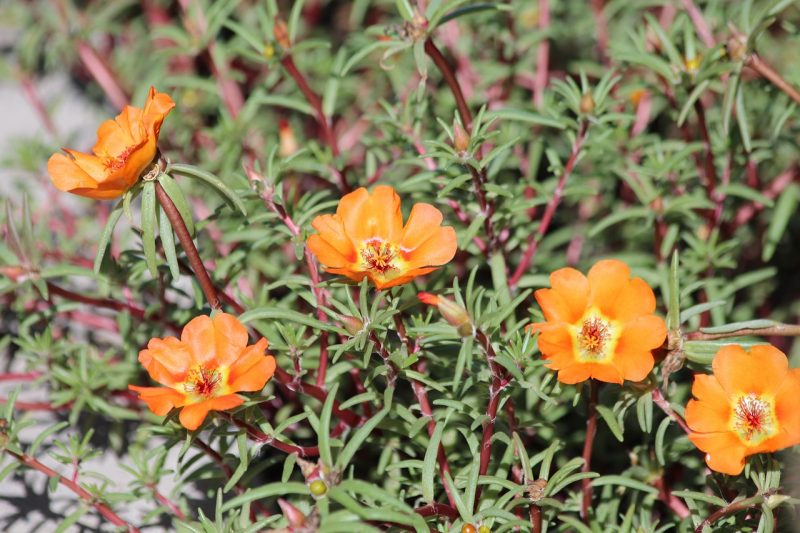You only need to tackle two steps to learn how to grow purslane from cuttings. While this summer annual typically reproduces by seeds, you’ll find it more convenient to propagate purslane from cuttings. Those who have a greenhouse can even use it to their advantage and use the stable conditions to encourage rooting faster.
While purslane grows easy, you still want to start in the greenhouse to ensure root development. Remember that even the easiest plant to grow can struggle to establish itself. You should provide favorable conditions of purslane in a controlled environment like the greenhouse.

Comprehensive Guide On How To Root Purslane From Cuttings
Step #1. Collecting and rooting
The first step in growing purslane from cuttings is collecting the sections. Like starting other plants with this propagation method, you want to use a healthy parent plant to ensure that it won’t get stressed after cutting. Besides, use a sharp and sterile knife to provide a clean cut and prevent diseases.
A six-inch section should suffice for rooting but remember to remove all the leaves at its bottom half. This way, you don’t risk rot when they make contact with the soil. After the preparation, you should be ready to plant the stem.
You can choose to start purslane cuttings in the ground or a container in the greenhouse. Perhaps it’s more advantageous to do the latter to maintain a stable environment. Place the cuttings in a moist medium and into somewhere bright but out of direct sunlight.
Step #2. Maintenance and transplanting
The maintenance practice that encourages root development on the cuttings is keeping the soil moist. Rooting can take a week, and you can check for resistance by tugging to indicate establishment. You can then water only when the soil is dry to prevent root rot.
If you started the plants indoors, don’t forget to gently acclimate them first before permanently transplanting them in the garden. This way, you won’t run the risk of transplant shock.
The excellent news with purslane is that these plants aren’t sensitive to the environment. Remember that this herb is a weed, making it easy-growing even in difficult dry areas. However, remember to maintain the plants by regularly harvesting them to keep them from becoming invasive.
How To Grow Purslane From Seeds
If you don’t have parent plants to take the cuttings from, you can quickly start purslane from seeds. They will proliferate in the garden, and they should be ready for harvesting after two months. Choose a fertile and well-draining site and ensure soil moisture.
You can also sow purslane seeds in the greenhouse. Fill containers with fertile soil and place them somewhere warm to encourage germination. Remember to keep the soil moist, but the plants will not survive the first frost in soil, so plan accordingly.
Harvesting Purslane For Best Flavor
If you want to ensure that you’re getting the tastiest purslane harvest, monitor the conditions of your plant. Did you know that picking the purslane leaves early in the day will guarantee the tartest flavor? This is because the plant conserves moisture during hot and dry conditions, leading to a stronger sour taste.
Uses Of Purslane
Besides using it as an herb, you can also benefit from purslane’s medicinal benefits. Studies have shown its medicinal value for treating various conditions such as headaches, coughs, burns, and arthritis. Purslane even works as a muscle relaxant, emollient, purgative, diuretic, cardiac tonic, and anti-inflammatory herbal medicine.
Purslane offers these benefits because of its nutritional components. It is high in antioxidants, including ascorbic acid, alpha-linolenic acid, and beta-carotene. However, it would help if you grew it in ideal conditions as this contributes to the purslane’s nutritional composition.
Why Is Purslane Invasive?
Purslane is a weedy annual that is grown as a salad plant. Its unique sweetness and acidity work well with other herbs. However, this plant can proliferate because of how fast it produces plenty of seeds. Therefore, you must learn to manage purslane before it colonizes an area.
Purslane can grow and overtake an area in just a year, leaving you dense vegetative mats. This can be problematic when you’re growing other seedlings because purslane blocks the light they’ll receive. More so, having carpets of poorly-managed purslane is unsightly while also affecting the quality of the low-growing crops.
You can manage purslane by mulching or covering the soil with a transparent plastic sheet called soil solarization. Some gardeners also add insects to eat purslane and keep them from reproducing. However, if all else fails, you can consider preemergent and post-emergent herbicides to control purslane.
Conclusion
Purslane typically grows from seeds, but you can also propagate this herb from cuttings. One can learn how to grow purslane from cuttings in two simple steps, which are no different from rooting other plants in this method. Select a healthy parent plant and take a six-inch section for planting.
Remove the lower leaves and plant them in the greenhouse to guarantee root establishment. Being a weed, purslane will grow quickly without many requirements. However, harvest your plants regularly because they can overgrow and take over the area.
Overall, purslane has many benefits, not limited to the kitchen. It can also work as herbal medicine. However, one must ensure the ideal growing conditions to guarantee that the purslane maintains its nutritional profile.
